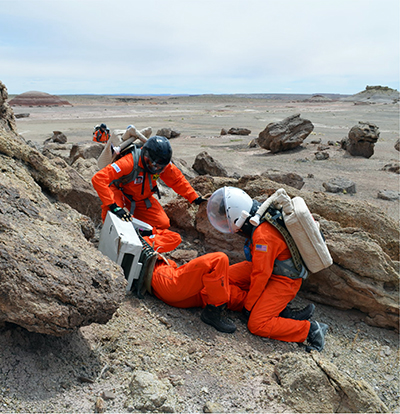PHYSICIANS IN SPACE
Program with CU Boulder to give medical students training for spaceflight
By Greg Glasgow
October 2022
 Space needs doctors, and a new joint MD-MS degree program between the University of Colorado School of Medicine and the Department of Aerospace Engineering Sciences at CU Boulder is aimed at giving medical students the skills they need to advance human spaceflight.
Space needs doctors, and a new joint MD-MS degree program between the University of Colorado School of Medicine and the Department of Aerospace Engineering Sciences at CU Boulder is aimed at giving medical students the skills they need to advance human spaceflight.
“The aerospace field is growing massively, especially in Colorado,” says Allie Anderson, PhD, assistant professor of aerospace engineering at CU Boulder. “The demand is definitely outpacing the supply. There are other engineering programs out there that include bioastronautics, but this new joint program puts a particular emphasis on creating a physician who’s equipped with a medical degree as well as engineering knowledge.”
Anderson and Ben Easter, MD, designed the new MD-MS program, based on Easter’s experiences as an assistant professor of emergency medicine. The new program expects to start accepting applications this fall and launch officially in fall 2023.
“To succeed in human spaceflight, you really need to understand both ends of the equation — to understand the engineering and the spacecraft system side, but also to understand humans and their interactions with those systems,” Easter says. “We’ve found that people traditionally have training on one side of that, but they don’t necessarily have expertise in both. This new joint degree program is focused on training students to understand and speak the language of medicine and of engineering.”
UTAH TRAINING STATION
The new program has its roots in Medicine in Space and Surface Environments (MiSSE), a three-year-old course designed by Easter and his colleagues. That three-week class takes students into the Utah desert each spring to practice their skills at the Mars Desert Research Station. In an environment with some similarities to the surface of the Red Planet, students navigate rugged topography and rapid-fire event simulations, organize into teams, and solve cascading problems, all the while racing the clock to save injured and ill crewmates.
“The idea is that you live as a crew in a remote environment that is analogous to Mars,” says Easter, who also is the deputy element scientist in NASA’s Exploration Medical Capability, part of the space agency’s Human Research Program. “You close the hatch, and then for the next two weeks, the only time you go outside is under the simulated conditions as if you were actually on the surface of Mars.”
MiSSE will be one of the courses in the new joint-degree program, a five-year curriculum that enhances the traditional four years of medical school with one additional year on the Boulder campus, where students earn a master’s degree in aerospace engineering, with a focus in bioastronautics, the study and support of life in space.
“They’ll do the first few years in medical school, take a one-year break to go to Boulder and complete the aerospace engineering side, then come back to finish their medical education,” Easter says. “We also will support them doing electives at government agencies or commercial spaceflight companies.”
CU NEXT AWARD
Easter and Anderson received a CU Next Award, a grant that helps faculty members working on an intercampus collaboration to purchase technology.
The award will help them to improve the technology and equipment at the desert research station and to create two new tech-focused courses around medicine and human spaceflight.
One course is a graduate-level engineering project tasking students with designing a simulated sick bay in the Utah desert; the other is an elective for first-year medical students introducing the challenges of medical care in extreme environments, including human spaceflight.
“It will be about changes in physiology in extreme environments, and understanding how to provide medical care in an operational setting,” Easter says. “It also will teach the students a lot about their interactions with technology as clinicians, and how that interacts with telemedicine. If you're a clinician who’s caring for patients millions of miles away, that's a very different experience of providing care than it is at the bedside.”